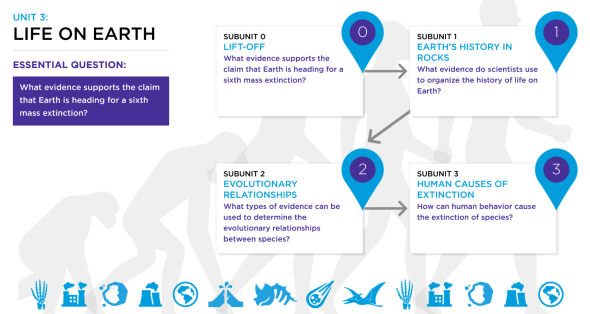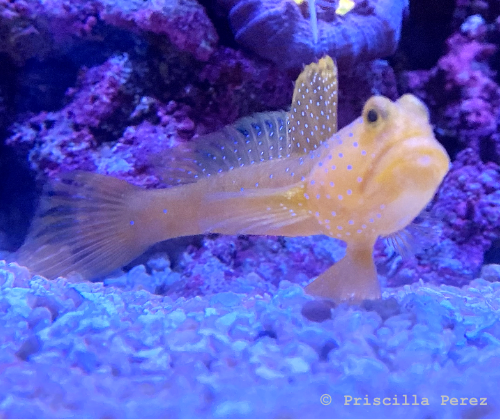
8th Grade Unit 3: Life on Earth Roadmap
This page hosts Unit 3: Life on Earth, and a roadmap of the 3 subunits that will be covered.
Subunit 1: Earth's History in Rocks
Link to this section
Below you will view and download:
🟩 Subunit Assessment Opportunities
🟩 5E Lesson Sequence
Subunit 1: Assessment Opportunities
Subunit 1 Assessment Opportunities
View and download (by making a copy)- Subunit 1 Assessments
What should my students know and be able to do?
What should I prioritize?
Note: The materials below are personal recommendations from teachers in the field.
Feel free to consider your context when deciding whether to follow these suggestions.
|
|
|
|
|
|
|
|
|
|
|
|
|
|
|
|
|
|
|
|
|
|
|
|
|
|
|
|
|
|
View and download (by making a copy)- Subunit 1 Assessments
Subunit 1: 5E Lesson Sequence
Subunit Description
📂 Download ALL lessons at one time for Unit 3: Subunit 1 from this folder. 📂
Throughout the course of this subunit, students investigate the characteristics of waves to figure out how to use waves to communicate during a power outage. During their investigations, students collect and analyze data as they manipulate the characteristics of water waves to determine how to predictably control a wave’s characteristics. Students develop initial ideas around the relationship between the amplitude of a wave and the amount of energy transmitted through a wave. These ideas coalesce into a model that explains how a wave’s characteristics can be manipulated and what happens to the energy of a wave when the wave’s characteristics change.
| Lesson | Lesson Name | Teacher Document | Student Handout |
|---|---|---|---|
| 1 | Engage | ||
| 2 | Explore | ||
| 3 | Explain | ||
| 4 | Elaborate | 8.3 SU1 4Elaborate Teacher | |
| 5 | Evaluate | ||
📂 Download ALL lessons at one time for Unit 3: Subunit 1 from this folder. 📂
Subunit 2: Evolutionary Relationships
Link to this section
Below you will view and download:
🟩 Subunit Assessment Opportunities
🟩 5E Lesson Sequence
Subunit 2: Assessment Opportunities
Subunit 2 Assessment Opportunities
View and download (by making a copy)- Subunit 2 Assessments
What should my students know and be able to do?
What should I prioritize?
Note: The materials below are personal recommendations from teachers in the field.
Feel free to consider your context when deciding whether to follow these suggestions.
|
|
|
|
|
|
|
|
|
|
|
|
|
|
|
|
|
|
|
|
|
|
|
|
|
|
|
|
|
|
View and download (by making a copy)- Subunit 2 Assessments
Subunit 2: 5E Lesson Sequence
Subunit Description
📂 Download ALL lessons at one time for Unit 3: Subunit 2 from this folder. 📂
In this subunit, students learn the three main types of evidence used to establish evolutionary relationships between species. Students also learn that these sources of evidence provide evidence for the theory of evolution itself.
| Lesson | Lesson Name | Teacher Document | Student Handout |
|---|---|---|---|
| 1 | Engage | ||
| 2 | Explore | ||
| 3 | Explain | ||
| 4 | Elaborate | 8.3 SU2 4Elaborate Teacher | 8.3 SU2 4Elaborate Student |
| 5 | Evaluate | ||
📂 Download ALL lessons at one time for Unit 3: Subunit 2 from this folder. 📂
Subunit 3: Human Causes of Extinction
Link to this section
Below you will view and download:
🟩 Subunit Assessment Opportunities
🟩 5E Lesson Sequence
Subunit 3: Assessment Opportunities
Subunit 3 Assessment Opportunities
What should my students know and be able to do?
What should I prioritize?
Note: The materials below are personal recommendations from teachers in the field.
Feel free to consider your context when deciding whether to follow these suggestions.
|
|
|
|
|
|
|
|
|
|
|
|
|
|
|
|
|
|
|
|
|
|
|
|
|
|
|
|
|
|
View and download (by making a copy)- Subunit 3 Assessments
Subunit 3: 5E Lesson Sequence
Subunit Description
📂 Download ALL lessons at one time for Unit 3: Subunit 3 from this folder. 📂
In this subunit, students explore how human increase in population and consumption have affected other species. Students analyze data showing increases in extinctions over the past 200 years and learn about how human behavior has contributed to the extinction of many species.
| Lesson | Lesson Name | Teacher Document | Student Handout |
|---|---|---|---|
| 1 | Engage | ||
| 2 | Explore | ||
| 3 | Explain | ||
| 4 | Elaborate | 8.3 SU3 4Elaborate Teacher | 8.3 SU3 4Elaborate Student |
| 5 | Evaluate | ||
📂 Download ALL lessons at one time for Unit 3: Subunit 3 from this folder. 📂
Unit 3: Life on Earth Documents
Link to this section
Below you will view and download: Unit Plan, Standards, Culminating Project Assessments and Rubrics, Common Misconceptions, Materials, Unit 0: Lift-Off Lessons and Resources.
8.3 Life on Earth: Overview
Overview
Through examining evidence, students explore the history of life on Earth. In Subunit 1, students use evidence from fossils and rock strata to determine when species evolved and became extinct. In Subunit 2, students use fossil, anatomical, and embryological evidence to determine evolutionary relationships between species. In Subunit 3, students investigate the connection between increases in human population, human consumption, and species extinctions.
For the Group Culminating Project, students work together to create a presentation about a potential sixth mass extinction event. For the Individual Culminating Project, each student focuses on an individual species that is in danger of extinction.
8.3 Life on Earth: Unit Plan
Unit 3: Life on Earth - Unit Plan
|
|
||
|
|
||
|
Construct a scientific explanation based on evidence from rock strata for how the geologic time scale is used to organize Earth's 4.6-billion-year-old history. [Clarification Statement: Emphasis is on how analyses of rock formations and the fossils they contain are used to establish relative ages of major events in Earth’s history. Examples of Earth’s major events could range from being very recent (such as the last Ice Age or the earliest fossils of homo sapiens) to very old (such as the formation of Earth or the earliest evidence of life). Examples can include the formation of mountain chains and ocean basins, the evolution or extinction of particular living organisms, or significant volcanic eruptions.] [Assessment Boundary: Assessment does not include recalling the names of specific periods or epochs and events within them.] Analyze and interpret data for patterns in the fossil record that document the existence, diversity, extinction, and change of life forms throughout the history of life on Earth under the assumption that natural laws operate today as in the past. [Clarification Statement: Emphasis is on finding patterns of changes in the level of complexity of anatomical structures in organisms and the chronological order of fossil appearance in the rock layers.] [Assessment Boundary: Assessment does not include the names of individual species or geological eras in the fossil record.] Apply scientific ideas to construct an explanation for the anatomical similarities and differences among modern organisms and between modern and fossil organisms to infer evolutionary relationships. [Clarification Statement: Emphasis is on explanations of the evolutionary relationships among organisms in terms of similarity or differences of the gross appearance of anatomical structures.] [Clarification Statement: Emphasis is on inferring general patterns of relatedness among embryos of different organisms by comparing the macroscopic appearance of diagrams or pictures.] [Assessment Boundary: Assessment of comparisons is limited to gross appearance of anatomical structures in embryological development.] Construct an argument supported by evidence for how increases in human population and per-capita consumption of natural resources impact Earth's systems. [Clarification Statement: Examples of evidence include grade-appropriate databases on human populations and the rates of consumption of food and natural resources (such as freshwater, mineral, and energy). Examples of impacts can include changes to the appearance, composition, and structure of Earth’s systems as well as the rates at which they change. The consequences of increases in human populations and consumption of natural resources are described by science, but science does not make the decisions for the actions society takes.]
|
|
|
|
|
||
|
|
||
|
|
||
|
|
||
|
|
||
|
|
||
|
|
||
|
|
||
|
|
||
Life on Earth
Essential Question: What evidence supports the claim that Earth is heading for a sixth mass extinction?
Lift-Off and Introduction to the Culminating Project
Subunit 1: Earth’s History in Rocks
What evidence do scientists use to organize the history of life on Earth?
Engage • Explore • Explain • Elaborate • Evaluate
Subunit 2: Evolutionary Relationships
What types of evidence can be used to determine the evolutionary relationships between species?
Engage • Explore • Explain • Elaborate • Evaluate
Subunit 3: Human Causes of Extinction
How can human behavior cause the extinction of species?
Engage • Explore • Explain • Elaborate • Evaluate
Group Culminating Project
Presentation on Mass Extinction
Individual Culminating Project
Focus on an Endangered Species
|
|
||||
|
|
|
|
|
|
|
|
|
|
|
|
|
|
|
|
|
|
|
|
|
|
||
|
|
|
|||
|
|
||||
|
|
|
|
||
|
|
|
|||
|
|
||||
|
|
|
|
|
|
|
|
|
|
|
|
|
|
|
|
|
|
|
|
|
|||
|
|
|
|||
|
|
|
|
||
|
|
|
|
||
|
|
|
|
||
|
|
|
|
||
8.3 Life on Earth: Standards
Life on Earth
Next Generation Science Standards Performance Expectations
|
|
Assessment Boundary: Assessment does not include recalling the names of specific periods or epochs and events within them.] |
|
|
|
|
|
[Clarification Statement: Emphasis is on explanations of the evolutionary relationships among organisms in terms of similarity or differences of the gross appearance of anatomical structures.] |
|
|
[Clarification Statement: Emphasis is on inferring general patterns of relatedness among embryos of different organisms by comparing the macroscopic appearance of diagrams or pictures.] [Assessment Boundary: Assessment of comparisons is limited to gross appearance of anatomical structures in embryological development.] |
|
|
|
NGSS Lead States. 2013. Next Generation Science Standards: For States, By States. Washington, DC: The National Academies Press.
Disciplinary Core Ideas
ESS1.C: The History of Planet Earth
- The geologic time scale interpreted from rock strata provides a way to organize Earth’s history. Analyses of rock strata and the fossil record provide only relative dates, not an absolute scale.
ESS3.C: Human Impacts on Earth Systems
- Typically as human populations and per-capita consumption of natural resources increase, so do the negative impacts on Earth unless the activities and technologies involved are engineered otherwise.
LS4.A: Evidence of Common Ancestry and Diversity
- The collection of fossils and their placement in chronological order (e.g., through the location of the sedimentary layers in which they are found or through radioactive dating) is known as the fossil record. It documents the existence, diversity, extinction, and change of many life forms throughout the history of life on Earth.
- Anatomical similarities and differences between various organisms living today and between them and organisms in the fossil record, enable the reconstruction of evolutionary history and the inference of lines of evolutionary descent.
- Comparison of the embryological development of different species also reveals similarities that show relationships not evident in the fully-formed anatomy.
Science and Engineering Practices
Constructing Explanations and Designing Solutions
Constructing explanations and designing solutions in 6–8 builds on K–5 experiences and progresses to include constructing explanations and designing solutions supported by multiple sources of evidence consistent with scientific ideas, principles, and theories.
- Construct a scientific explanation based on valid and reliable evidence obtained from sources (including the students’ own experiments) and the assumption that theories and laws that describe the natural world operate today as they did in the past and will continue to do so in the future. (MS-ESS1-4)
*Engaging in Argument from Evidence (Focal Practice)
Engaging in argument from evidence in 6–8 builds on K–5 experiences and progresses to constructing a convincing argument that supports or refutes claims for either explanations or solutions about the natural and designed world(s).
- Construct an oral and written argument supported by empirical evidence and scientific reasoning to support or refute an explanation or a model for a phenomenon or a solution to a problem. (MS-ESS3-4)
Analyzing and Interpreting Data
Analyzing data in 6–8 builds on K–5 experiences and progresses to extending quantitative analysis to investigations, distinguishing between correlation and causation, and basic statistical techniques of data and error analysis.
- Analyze and interpret data to determine similarities and differences in findings. (MS-LS4-1)
- Analyze displays of data to identify linear and nonlinear relationships. (MS-LS4-3)
Asking Questions and Defining Problems
Constructing explanations and designing solutions in 6–8 builds on K–5 experiences and progresses to include constructing explanations and designing solutions supported by multiple sources of evidence consistent with scientific ideas, principles, and theories.
Apply scientific ideas to construct an explanation for real-world phenomena, examples, or events. (MS-LS4-2)
Crosscutting Concepts
Scale, Proportion, and Quantity
- Time, space, and energy phenomena can be observed at various scales using models to study systems that are too large or too small. (MS-ESS1-4)
Cause and Effect
- Cause and effect relationships may be used to predict phenomena in natural or designed systems. (MS-ESS3-4)
*Patterns (Focal Crosscutting Concept)
- Graphs, charts, and images can be used to identify patterns in data. (MS-LS4-1, MS-LS4-3)
- Patterns can be used to identify cause and effect relationships. (MS-LS4-2)
“Disciplinary Core Ideas, Science and Engineering Practices, and Crosscutting Concepts” are reproduced verbatim from A Framework for K-12 Science Education: Practices, Crosscutting Concepts, and Core Ideas. DOI: https://doi.org/10.17226/13165. National Research Council; Division of Behavioral and Social Sciences and Education; Board on Science Education; Committee on a Conceptual Framework for New K-12 Science Education Standards. National Academies Press, Washington, DC. This material may be reproduced for noncommercial purposes and used by other parties with this attribution. If the original material is altered in any way, the attribution must state that the material is adapted from the original. All other rights reserved.
Connections to the Nature of Science
Science Addresses Questions About the Natural and Material World
- Scientific knowledge can describe the consequences of actions but does not necessarily prescribe the decisions that society takes. (MS-ESS3-4).
Scientific Knowledge Assumes an Order and Consistency in Natural Systems
- Science assumes that objects and events in natural systems occur in consistent patterns that are understandable through measurement and observation. (MS-ESS3-4, MS-LS4-2).
Connections to Engineering, Technology, and Applications of Science
Influence of Science, Engineering, and Technology on Society and the Natural World
- All human activity draws on natural resources and has both short and long-term consequences, positive as well as negative, for the health of people and the natural environment. (MS-ESS3-4).
NGSS Lead States. 2013. Next Generation Science Standards: For States, By States. Washington, DC: The National Academies Press.
Link to Connect the 8th Life on Earth Unit with Prior Knowledge.
8.3 Life on Earth: Culminating Project Assessments and Rubrics
Culminations Project Assessments and Rubrics
📂Download ALL files at one time from the 8.3 Culminating Project Assessments folder.📂
| Culminating Project File Docs |
|---|
| 8.3 Main–Culminating Projects |
| 8.3 Oral Presentation Rubric |
| 8.3 Science Content Rubric |
| 8.3 Science and Engineering Practices Rubric |
📂Download ALL files at one time from the 8.3 Culminating Project Assessments folder.📂
8.3 Life on Earth: Common Misconceptions
Common Misconceptions
View and download (by making a copy) 8.3 Common Misconceptions
Lift-Off
|
|
|
|
|
|
Subunit 1: Earth’s History in Rocks
|
|
|
|
|
|
|
|
|
Subunit 2: Evolutionary Relationships
|
|
|
|
|
|
Subunit 3: Human Causes of Extinction
|
|
|
|
|
|
View and download (by making a copy) 8.3 Common Misconceptions
8.3 Life on Earth: Materials
Materials
The Unit 3: Life on Earth Materials table includes all of the items needed to teach five sections of this unit in a classroom of 32 students (eight groups of four). A detailed breakdown of how these items are used throughout the unit can be found in your Teacher Background Section at the subunit level and in each individual lesson in your Teacher Edition.
- Permanent materials have already been provided to all middle schools in the district and are expected to be reused from year to year.
- Consumable materials are replenished on an as-needed basis from year to year.
- Teacher-provided materials must be supplied by teachers each year.
Unit 3: Life on Earth Materials
|
|
|
|
|
|
|
|
8.3 Life on Earth: Subunit 0: Lift-Off Lessons
Subunit 0: Lift-Off
📂 Download ALL lessons at one time for Subunit 0: Lift-Off from this folder.📂
Lessons
| Lift-Off Lesson Documents |
|---|
| 8.3 SU0 Liftoff Slides |
| 8.3 SU0 Liftoff Groupwork Slides |
| 8.3 SU0 Liftoff Teacher |
| 8.3 SU0 Liftoff Student |
📂 Download ALL lessons at one time for Subunit 0: Lift-Off from this folder.📂
8.3 Life on Earth: Want to know more about this unit?
Want to know more about this unit?
Resources
Here are some resources for Unit 8.3 Life on Earth:
Subunit 1: Earth’s History in Rocks
U.S. Geological Survey: Fossils, Rocks, and Time
“FOSSILS, ROCKS, AND TIME.” Fossils, Rocks, and Time: Table of Contents. Accessed November 18, 2019. https://pubs.usgs.gov/gip/fossils/contents.html.
Subunit 2: Evolutionary Relationships
University of California Museum of Paleontology: Understanding Evolution
Understanding Evolution. 2019. University of California Museum of Paleontology. Accessed November 18, 2019. https://evolution.berkeley.edu/evolibrary/home.php.
Howard Hughes Medical Institute BioInteractive: Evolution
“Classroom Resources.” HHMI BioInteractive. Accessed November 18, 2019. https://www.biointeractive.org/classroom-resources?search=&f[0]=topics:57.
Subunit 3: Human Causes of Extinction
International Union for Conservation of Nature Red List of Threatened Species
“The IUCN Red List of Endangered Species.” IUCN red list, n.d.
https://www.iucnredlist.org/.
This is a resource that students can use to choose and research an endangered species for their project.
Zoological Society of London: Priceless or Worthless?
“Priceless Or Worthless?” iucn.org, n.d. https://portals.iucn.org/library/sites/library/files/documents/2012-096.pdf.
This publication outlines the 100 most threatened species on Earth and conservation strategies.
Howard Hughes Medical Institute Posters
“The Making of Mass Extinctions.” HHMI BioInteractive. Accessed April 14, 2020. https://www.biointeractive.org/classroom-resources/making-mass-extinctions.
Assessments
Stanford University: Stanford NGSS Assessment Project
“Search.” Search | Stanford NGSS Assessment Project. Accessed November 19, 2019. https://snapgse.stanford.edu/search/node/MS-LS2-5.
Other Resources in 8.3 Life on Earth
“Developmental Similarities: Karl von Baer” Understanding Evolution. University of California Museum of Paleontology. Accessed November 18, 2019.
https://evolution.berkeley.edu/evolibrary/article/history_10
Evidence of Evolution. YouTube. YouTube. Accessed November 19, 2019. https://www.youtube.com/watch?v=cC8k2Sb1oQ8&feature=youtube_gdata_player.
“Evolving Ideas: How Do We Know Evolution Happens?” PBS LearningMedia. Evolution Series, October 29, 2019. https://ca.pbslearningmedia.org/resource/tdc02.sci.life.evo.howhappens/evolving-ideas-how-do-we-know-evolution-happens/#.W2Hv4dJKha.
“Evolution: Strategies for Minimizing Conflict about Teaching Evolution.” PBS. Public Broadcasting Service. Accessed November 19, 2019. http://www.pbs.org/wgbh/evolution/educators/course/session8/elaborate_c_pop1.html.
“Evolution: Library: Tetrapod Limbs.” PBS. Public Broadcasting Service. Accessed November 18, 2019. http://www.pbs.org/wgbh/evolution/library/04/2/image_pop/l_042_01.html.
“Extinctions and Human Population.” Tuva. Accessed November 19, 2019. https://tuvalabs.com/datasets/extinctions_and_human_population/activities.
“Fish with Fingers.” PBS LearningMedia. Evolution Series, October 21, 2019. https://ca.pbslearningmedia.org/resource/tdc02.sci.life.evo.fishfingers/fish-with-fingers/.
“Fossil Evidence.” Understanding Evolution. University of California Museum of Paleontology. Accessed November 18, 2019.
https://evolution.berkeley.edu/evolibrary/article/0_0_0/lines_02
“Guess the Embryo.” PBS. Public Broadcasting Service. Accessed November 18, 2019. http://www.pbs.org/wgbh/nova/evolution/guess-embryo.html.
How a Single Asteroid Wiped Dinosaurs Off This Planet video YouTube. YouTube. Accessed November 19, 2019.
https://www.youtube.com/watch?v=u_JZObDetfQ.
“Homologies” Understanding Evolution. University of California Museum of Paleontology. Accessed November 18, 2019.
https://evolution.berkeley.edu/evolibrary/article/0_0_0/lines_04.
National Science Teachers Association - NSTA. “NSTA Position Statement.” NSTA Position Statement: Evolution. Accessed November 19, 2019.
https://www.nsta.org/about/positions/evolution.aspx.
“NOVA: Judgment Day: Intelligent Design on Trial: Transitional Tetrapod Fossil.” PBS LearningMedia. NOVA, October 25, 2019. https://ca.pbslearningmedia.org/resource/evol07.sci.life.evo.fossilev/transitional-tetrapod-fossil/#.W2HwL9JKhaQ
“SIRS Issues Research.” Proquest, n.d. https://explore.proquest.com/sirsissuesresearcher/login?location=/sirsissuesresearcher?.
“The Tale of the Limb .” Accessed November 18, 2019. https://evolution.berkeley.edu/evolibrary/article/0_0_0/similarity_hs_02.
“The Tetrapod Limb.” Accessed November 18, 2019. https://evolution.berkeley.edu/evolibrary/article/0_0_0/similarity_hs_03
UCMP Web Lift to Taxa. Accessed November 19, 2019.
https://ucmp.berkeley.edu/help/taxaform.html.
View and download (by making a copy) of Resources
Note: The CC BY-NC 4.0 License does not apply to photos, images, articles, and other materials within the curriculum that have been licensed by San Francisco Unified School District and Stanford University (the Authors). These include but are not limited to photos from commercial stock photo/image agencies such as Shutterstock.com or Getty Images (iStock.com) and photos or graphics where the Authors obtained permission from organizations such as UCMP or SERP. This CC BY-NC 4.0 License also does not apply to articles that the Authors received permission to reprint [Reprinted with Permission]. You can identify such a photo, image, or licensed material by looking at the credit embedded within or associated with the content. You are allowed to reproduce the licensed material for your own personal, classroom, non-commercial use only, BUT (i) you may not modify, alter, adapt, or otherwise create any derivative work from, a licensed material and (ii) you may not distribute, transmit or disseminate a licensed material or any copy or derivative work thereof, to any third party, whether by itself, as part of a large works, or otherwise.
Note also, that throughout the student pages, there are some icons created by SFUSD and Stanford that may not have a credit line because of lack of space.
The general icons that follow were created by the San Francisco Unified School District and Stanford University and are all [CC BY-NC 4.0]:
These culminating project icons that follow were created or photographed by the San Francisco Unified School District and Stanford University and are all [CC BY-NC 4.0]:
8th Grade Science Units Link to this section
This page was last updated on July 25, 2023







